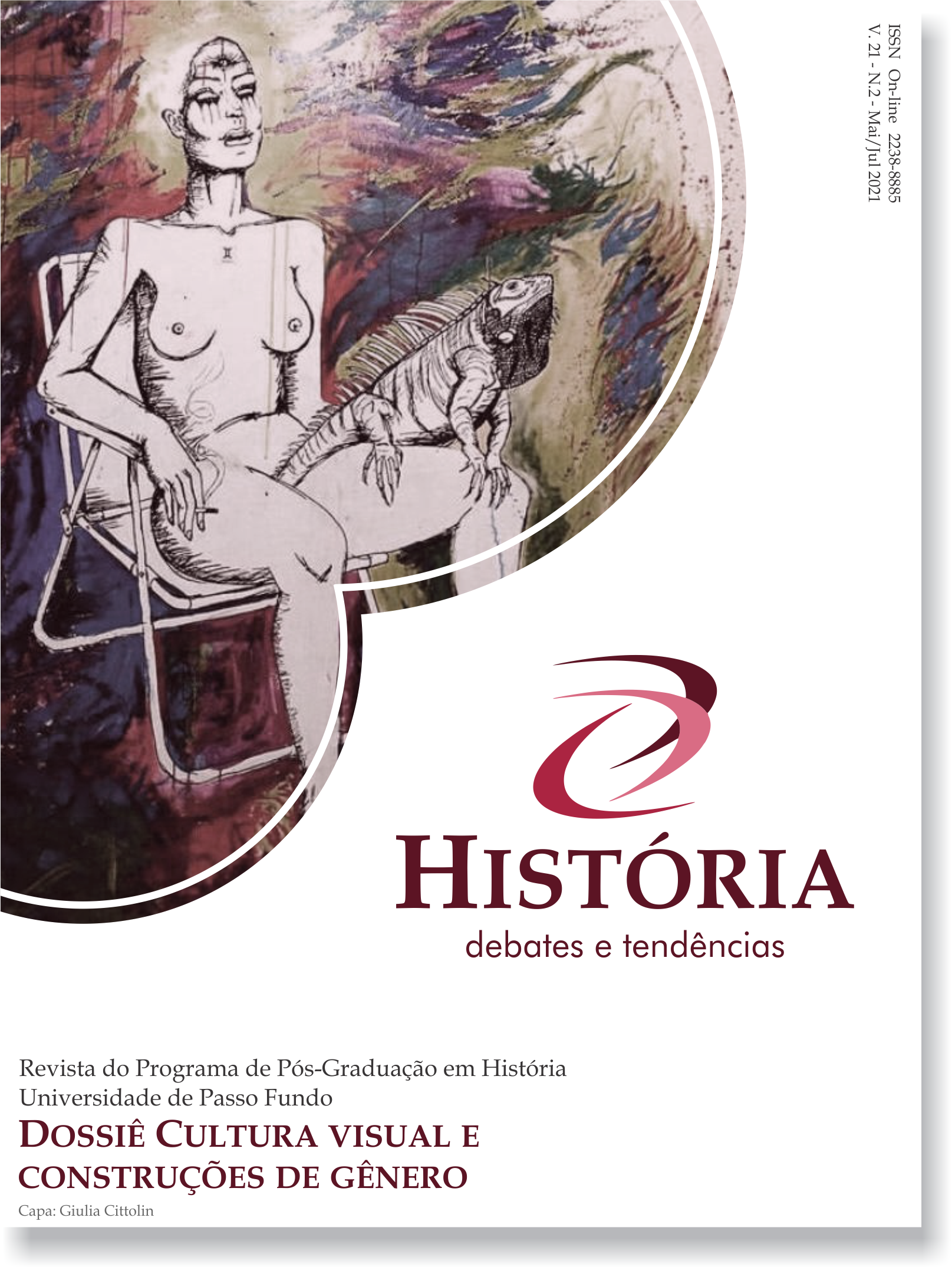Harlem renaissance:
“To die to be born and writing from you”
DOI:
https://doi.org/10.5335/hdtv.21n.2.11096Keywords:
Antiracism, Arts, Harlem Renaissance.Abstract
Harlem Renaissance was a movement that emerged in the 1920s by black professors, researchers, writers and artists in the United States, most intensely in the Harlem neighborhood of New York City. This renaissance movement was a possibility of confronting the construction of prejudice and stereotypes about the Black population. It was a moment of “self-writing”, in which Black people wore of the literature, music, painting and theater to talk about themselves in the first person, to report their fears, wins, anguish and anxieties from the perspective and subjectivities of those who experienced these feelings, and no longer from by the look of the outsider.
Downloads
Download data is not yet available.
References
CARVALHO, Noel dos Santos. O cinema em negro e branco. IN: SOUZA, Edileuza Penha de. (Org.). Negritude, cinema e educação: caminhos para a implementação da Lei 10.639/2003. Vol. 1. Belo Horizonte: Mazza Edições. 2011, pp. 17-30.
FANON, Frantz. Peles Negras, Máscaras Brancas. Tradução de Renato da Silveira. Salvador, Editora UDUFBA, 2008.
FOUCAULT, Michel. A escrita de Si. In: MOTTA, Manoel Barros da (Org.) “Michel Foucault: Ética, sexualidade, política”. Ditos e Escritos. Vol. V. Rio de Janeiro: Forense, 2004, p. 144-162.
GALBRAITH, John Kenneth. 1929, o colapso da bolsa. São Paulo: Pioneira, 1988.
GATES JR, Henry Louis; MCKAY, Nellie Y. The Norton anthology of African American literature. New York: W.W. Norton & Co. 1997. 1 ed.
GAZIER, Bernard. A Crise de 1929. Porto Alegre: L&PM Editores, 2009.
HALL, Stuart. Da diáspora: identidades e mediações culturais. Belo Horizonte: Editora UFMG, 2006.
HARDEN, Renata; JACKSON, Christopher K; PITTS, Berlethia J. Reading the Harlem Renaissance into Public Policy: Lessons from the Past to the Present. Afro-Americans in New York Life and History; Jul 2012; 36, 2. Ethnic News Watch, p. 07-36.
HILLSTROM, Kevin. Defining Moments: The Harlem Renaissance. New York. Omnigrphics, Inc. 2008.
HOBSBAWM, E. J. Era dos extremos: o breve século XX: 1914-1991. 2. ed. São Paulo: Companhia das Letras, 1995
JOHNSON, James Weldon. The Dilemma of the Negro Author. The American Mercury, 1928.
JORDAN, Tim. Activism! London: Reaktion Books, 2002.
LOCKE, Alain, ed. Harlem: Mecca of the New Negro. Spec, issue of Survey Graphics 53 (March 1925).
OLIVA, Anderson Ribeiro. Os africanos entre representações: viagens reveladoras, olhares imprecisos e a invenção da África no Imaginário Ocidental. Em tempo de Histórias, Brasília, n° 9, ano 9, p. 90-114, 2005.
PARKER, Selwyn. O Crash de 1929: As lições que ficaram da grande depressão. São Paulo: Globo, 2009
RICHES, William Terence Martin. The Civil Rights Movement: Struggle and Resistance. New York: St. Martin's Press, 1997.
SCHUCMAN, Lia Vainer. Entre o “encardido”, o “branco” e o “branquíssimo”: raça, hierarquia e poder na construção da branquitude paulistana. Tese de doutorado, Universidade de São Paulo - São Paulo, 2012.
TYLER, Bruce M. From Harlem to Hollywood: The Struggle for Racial and Cultural Democracy – 1920-1943. New York: Garland, 1992.
FANON, Frantz. Peles Negras, Máscaras Brancas. Tradução de Renato da Silveira. Salvador, Editora UDUFBA, 2008.
FOUCAULT, Michel. A escrita de Si. In: MOTTA, Manoel Barros da (Org.) “Michel Foucault: Ética, sexualidade, política”. Ditos e Escritos. Vol. V. Rio de Janeiro: Forense, 2004, p. 144-162.
GALBRAITH, John Kenneth. 1929, o colapso da bolsa. São Paulo: Pioneira, 1988.
GATES JR, Henry Louis; MCKAY, Nellie Y. The Norton anthology of African American literature. New York: W.W. Norton & Co. 1997. 1 ed.
GAZIER, Bernard. A Crise de 1929. Porto Alegre: L&PM Editores, 2009.
HALL, Stuart. Da diáspora: identidades e mediações culturais. Belo Horizonte: Editora UFMG, 2006.
HARDEN, Renata; JACKSON, Christopher K; PITTS, Berlethia J. Reading the Harlem Renaissance into Public Policy: Lessons from the Past to the Present. Afro-Americans in New York Life and History; Jul 2012; 36, 2. Ethnic News Watch, p. 07-36.
HILLSTROM, Kevin. Defining Moments: The Harlem Renaissance. New York. Omnigrphics, Inc. 2008.
HOBSBAWM, E. J. Era dos extremos: o breve século XX: 1914-1991. 2. ed. São Paulo: Companhia das Letras, 1995
JOHNSON, James Weldon. The Dilemma of the Negro Author. The American Mercury, 1928.
JORDAN, Tim. Activism! London: Reaktion Books, 2002.
LOCKE, Alain, ed. Harlem: Mecca of the New Negro. Spec, issue of Survey Graphics 53 (March 1925).
OLIVA, Anderson Ribeiro. Os africanos entre representações: viagens reveladoras, olhares imprecisos e a invenção da África no Imaginário Ocidental. Em tempo de Histórias, Brasília, n° 9, ano 9, p. 90-114, 2005.
PARKER, Selwyn. O Crash de 1929: As lições que ficaram da grande depressão. São Paulo: Globo, 2009
RICHES, William Terence Martin. The Civil Rights Movement: Struggle and Resistance. New York: St. Martin's Press, 1997.
SCHUCMAN, Lia Vainer. Entre o “encardido”, o “branco” e o “branquíssimo”: raça, hierarquia e poder na construção da branquitude paulistana. Tese de doutorado, Universidade de São Paulo - São Paulo, 2012.
TYLER, Bruce M. From Harlem to Hollywood: The Struggle for Racial and Cultural Democracy – 1920-1943. New York: Garland, 1992.
Downloads
Published
2021-05-05
Issue
Section
Artigos Livres
License
Authors who publish in this journal agree to the following terms: Authors retain the copyright and grant the journal the right of first publication, with the work simultaneously licensed under the Creative Commons Attribution License which allows the sharing of work with acknowledgment of authorship and initial publication in this journal. Authors are authorized to take additional contracts separately, for non-exclusive distribution of the version of the work published in this journal (eg, publish in institutional repository or as a book chapter), with acknowledgment of authorship and initial publication in this journal. Authors are allowed and encouraged to publish and distribute their work online (eg in institutional repositories or on their personal page) at any point before or during the editorial process, as this can generate productive changes as well as increase the impact and the citation of the published work (See The Effect of Free Access).How to Cite
Harlem renaissance:: “To die to be born and writing from you”. (2021). História: Debates E Tendências, 21(2), 117-129. https://doi.org/10.5335/hdtv.21n.2.11096






